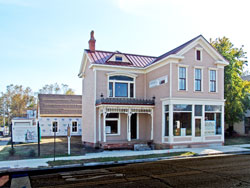Archbishop Buechlein blesses restoration project at Cardinal Ritter center in New Albany

The exterior of the home in which Cardinal Joseph E. Ritter was born in 1892 in New Albany has largely been restored. Work still needs to be completed on its interior and on an addition to the back of the home, which will likely be used for community meetings. (Photo by Sean Gallagher)
By Sean Gallagher
NEW ALBANY—In 1961, David Hock was a 10-year-old growing
up in New Albany.
That year, his hometown honored one of its native sons, Archbishop Joseph E. Ritter, after he was named a cardinal by Pope John XXIII.
After receiving his red hat, Cardinal Ritter returned to New Albany for a reception.
“I shook his hand. And then I went back to my friend, Bill Lori [now bishop of the Diocese of Bridgeport, Conn.], and said, ‘I think he’s somebody. Who is he?,” Hock asked. “That summer, we went on our bicycles around town and tried to find where he lived.”
Hock’s childhood interest in his hometown hero was renewed about five years ago as he got involved in the restoration of Cardinal Ritter’s home.
Hock, a member of Our Lady of Perpetual Help Parish in New Albany, is chairman of the board of Cardinal Ritter Birthplace Foundation, which owns the home and is overseeing its restoration.
Archbishop Daniel M. Buechlein traveled to New Albany on Oct. 28 to bless the restoration project of the house. Dozens of the restoration’s supporters were in attendance.
“The project has been in my mind. It’s been in my prayer. And I’m delighted,” said Archbishop Buechlein. “I’m sure Cardinal Ritter, when he was a seminarian at Saint Meinrad, had no idea that he would become the personage that he became.”
Born in 1892 in New Albany, Cardinal Ritter grew up just blocks away from St. Mary Parish. After becoming a seminarian for the then-Diocese of Indianapolis, he received his priestly formation at Saint Meinrad Seminary in St. Meinrad and was ordained a priest in 1917.
He was named an auxiliary bishop of Indianapolis in 1933, and became the bishop of the diocese a year later.
In 1946, he was named the archbishop of St. Louis then was made a cardinal in 1961.
Cardinal Ritter participated in the Second Vatican Council, strongly supporting its “Declaration on Religious Freedom.”
At home, Cardinal Ritter was an outspoken advocate of racial integration of Catholic schools in Indianapolis and St. Louis.
“A memorial like this is not something that Cardinal Ritter would have asked for,” Archbishop Buechlein said. “But it’s truly a worthy way of, in a certain sense, evangelizing in this part of southern Indiana because he was a courageous man.”
Letty Walter, a 73-year-old member of St. Mary Parish, remembers hearing about Cardinal Ritter as she grew up, and she still looks up to him.
“I feel his presence,” she said. “He went to the same school that I did. I may have knelt on the same kneeler that he knelt on when he was in church. He is an inspiration in the way that he lived his life.”
Walter, who is a member of the foundation’s board of directors, said she hopes that the restoration of Cardinal Ritter’s home will allow his legacy to shape a new generation.
“I want to make sure that the kids today get [his] message,” she said. “Kids need to know how God has blessed us. The cardinal is looking out after us.”
Although much of the exterior and the frame of the Ritter home has been restored, extensive work is still needed on the interior.
Foundation members intend in the future to lease the home as office space for non-profit organizations.
There is also space dedicated in the home for a Cardinal Ritter museum.
A large addition on the back of the house is under construction and will likely be used in the future for community meetings.
(Approximately $150,000 is needed to complete the restoration of the Cardinal Ritter Home. For more information about the home and how to donate to its restoration, log on to www.cardinalritterhouse.org or call
502-291-3131.) †
